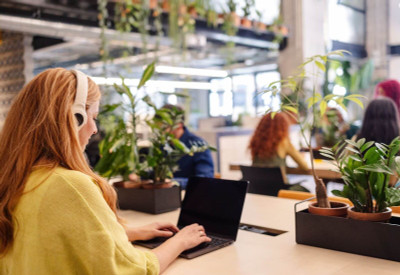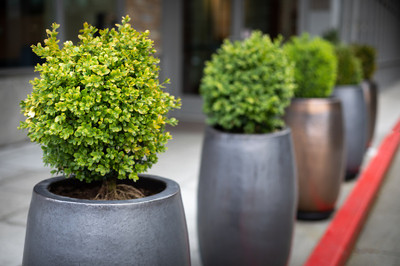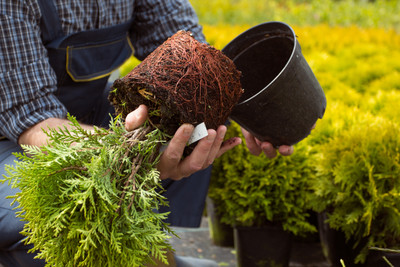The Best Planters for Office Common Areas (2026 Guide): Sizes, Materials, Layouts & Maintenance
Posted by Jason Wyrwicz on Oct 31st 2025
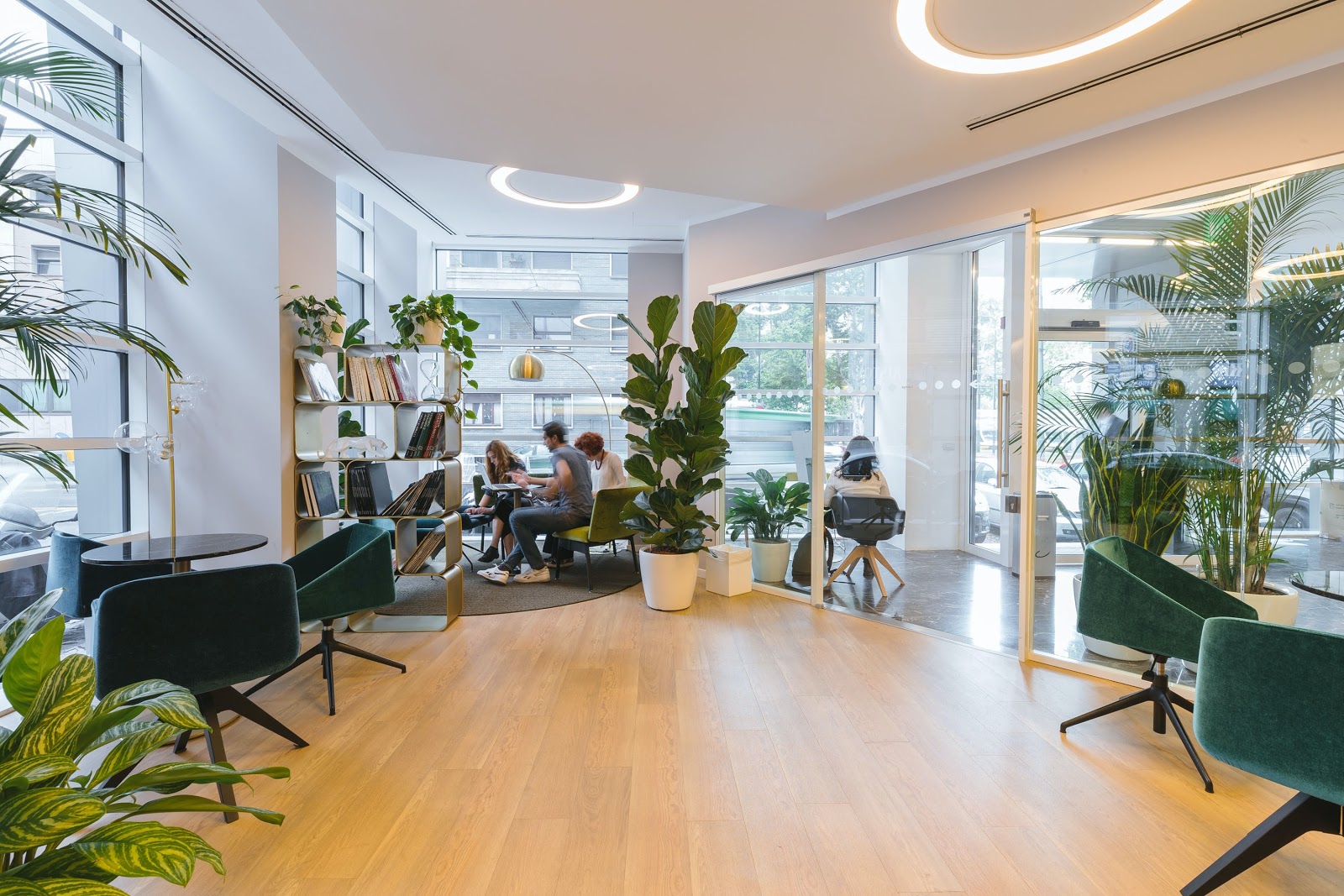
Office lobbies, corridors, lounges, and cafés all deserve a bit of greenery. The right planters can make these common areas feel more open, welcoming, and easier to move through, while quietly boosting focus and lifting the mood.
In this guide, we’ll walk through how to choose the best sizes, materials, and layouts for each area. You’ll also get simple tips for plant pairings, drainage setups, and low-maintenance care, so everything stays fresh without the fuss.
Quick tip: Think in zones. A planter that works in a wide, busy lobby probably won’t fit a narrow hallway. Below, we’ve pulled together quick picks by space type, followed by deeper tips on sizing, finishes, placement, and more.
Quick Picks by Common Area
Lobby / Reception
Tall, rectangular, or round planters are best suited for this space. They guide flow and anchor the space near entryways. Go with matte or low-sheen finishes in black, white, gray, or metal tones.
Quick Picks:
- Saint Tropez Tall Vase Planter Pot – 36" tall, 20+ finishes, 2–3 week lead time.
- Potsdam Large Rectangular Planter Box – Long and low, 15 finishes, ships in 10–15 business days.
- Toulan Tapered Tall Square Planter – Slim profile, 18 finishes, fast turnaround.
Elevator Banks & Corridors
Choose slim rectangular planters around 8–12" deep to guide movement without blocking walkways. Waist-height styles are best.
Quick Picks:
- Camoux Narrow Planter Box – 8" depth, 15+ finishes, 10–15 day lead time.
- Salon Narrow Window Box Planter – 10" deep, matte finish, indoor-ready with optional liner.
Lounges & Collaboration Zones
Use medium-height cube or round planters in small clusters to break up space and add softness. Mix heights and plant types for a relaxed feel.
Quick Picks:
- Montroy Cube Planter Box – Small to large sizes, 20+ finishes, 2–3 week lead time.
- Valencia Round Planter – 18" and 24" sizes, 15+ finishes, lightweight and durable.
Cafés & Break Rooms
Planters here should be easy to clean and maintain. Choose satin or glossy finishes and look for liner-ready or self-watering styles.
Quick Picks:
- Rio Grande Cylinder Planter – Satin finish, liner-ready, 15+ finishes, ships in 2–3 weeks.
Atriums & Terraces
Large planters with weight and durability are key. Go with fiberstone, concrete, or oversized fiberglass, and always use UV-stable finishes.
Quick Picks:
- Perth Tall Planter Box – Stone-like fiberstone, sturdy enough for small trees.
Sizing & Layouts That Work
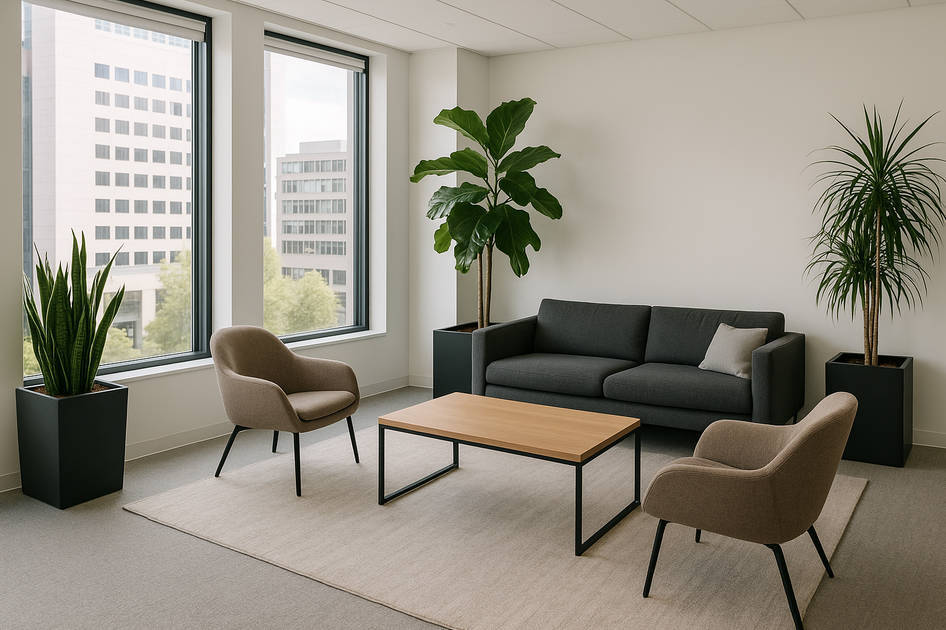
Selecting the right size planter isn’t just about the plant’s current size; it’s about the intent. Are you creating a focal point, a privacy screen, or a subtle border? Here’s how to size your planters for different goals:
- Focal Points: For bold statement plants in lobbies or receptions, go big. Planters 30″+ tall can hold larger plants like fiddle leaf figs or dracaenas. Make sure the diameter gives roots space — 2–4 inches wider than the root ball is a good guide.
- Privacy & Division: To create soft barriers between spaces, use 24–36″ tall planters with fuller plants. A row of these adds privacy at seated height. Choose planters with wide bases so they stay stable.
- Edges & Pathways: Low-profile planters (12–18″ tall) work well along hallways or café lines. They guide flow without blocking views. Just keep at least 36″ of walking space clear for comfort and accessibility.
Leave Room to Grow: Always size up slightly. A plant in an 8″ pot will be happier in a 10–12″ planter. It gives the roots space and reduces how often you’ll need to repot.
Mind Door Swings & Turning Radius: Make sure doors can open fully and that planters don’t block turning areas. Leave enough space at corners and intersections, at least a 5-foot turning circle, to keep things accessible.
To help connect planter size to use, here’s a handy quick reference:
Planter Height vs. Use Case vs. Suggested Plants
|
Planter Height |
Best Use Case |
Example Plants (that fit) |
|
12–18 inches |
Low accents (cafés, end tables) |
Trailing pothos, small ferns, Peperomia |
|
20–30 inches |
Lounge clusters, room dividers |
ZZ plant, snake plant, rubber plant |
|
30–40+ inches |
Lobby focal points, privacy screens |
Ficus varieties (e.g., Fiddle Leaf Fig), Bamboo palm, large Dracaena |
What to Know About Office Planter Materials
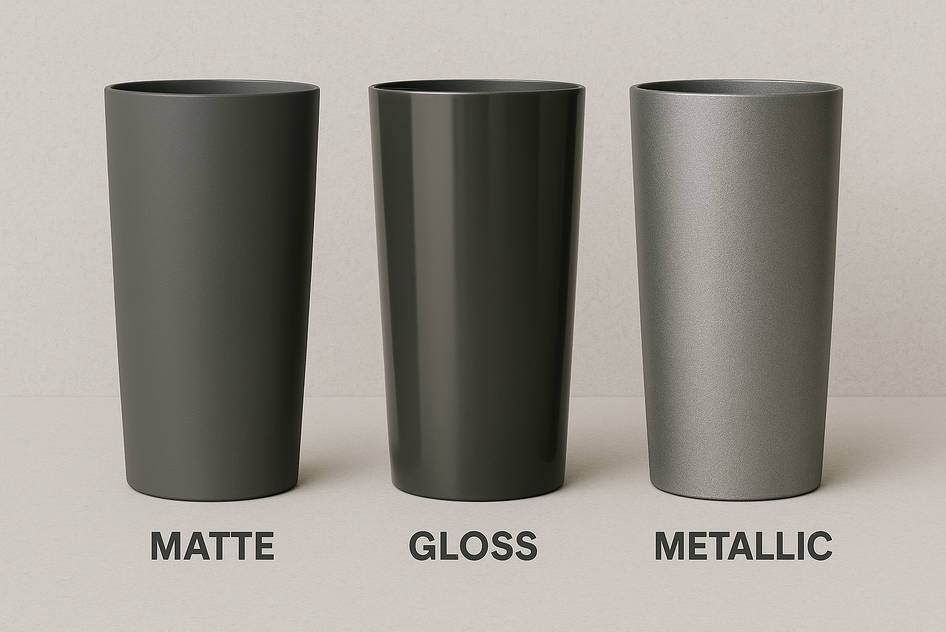
Office planters come in many materials, each with its own perks for busy spaces. The right choice affects weight, upkeep, and overall look. Here’s a comparison of common planter materials and how they stack up for office use:
- Fiberglass: The all-round winner for offices. It’s lightweight, durable, and suitable for use indoors or outdoors. Fiberglass doesn’t crack or rot, holds color well, and comes in dozens of finishes. It costs more than plastic but lasts for years and keeps its sleek look.
- Metal (Aluminum or Steel): Ideal for modern spaces. Aluminum is light and rust-proof; steel is heavier and ultra-sturdy. Both have powder-coated finishes that resist wear, but scratches can expose steel to rust. Best for lobbies or design-forward spots.
- Concrete or Stone: Built for permanence, these planters stay put in outdoor or atrium settings and give a bold, architectural feel. They’re nearly indestructible but very heavy. Once placed, they’re staying there.
- Resin/Plastic: Budget-friendly and light, resin planters are easy to move and won’t chip. Go for UV-protected ones if near sunlight. Cheap versions can fade or crack, so invest in high-grade options and add some weight for stability.
- Wood: Warm and natural. Great for relaxed lounges or biophilic designs. Teak or cedar lasts longest, but wood needs sealing and an inner liner to protect it from moisture. Best used as accent pieces, not in high-humidity areas.
Drainage, Liners & Self-Watering
One of the trickiest parts of interior landscaping is watering. Too little and plants suffer, too much and you risk leaks or root rot. Luckily, there are tools and techniques to make watering a breeze while protecting your office floors.
Let’s break down the key points on drainage, liners, and self-watering systems:
- Indoor Drainage: Skip open drain holes; instead, use sealed-bottom planters with liners to avoid leaks. Liners hold soil and water safely, and many are removable for easy cleanup.
- Outdoor & Atrium Drainage: For outdoor or atrium setups, drainage holes matter. Use planters with plugs or liners that you can empty to prevent water from pooling after rain.
- Why Liners Help: They prevent spills, reduce soil use, and make planters lighter. You can also lift them out to prune roots or swap plants. Just make sure to check for standing water inside.
- Self-Watering Options: Planters with built-in reservoirs allow plants to absorb water slowly, reducing how often you need to water. They’re ideal for offices with less frequent care.
- Overflow Protection: Look for planters with overflow tubes or drip-safe designs. For indoors, you can use absorbent mats or route overflow into hidden containers.
- Smart Filling: Don’t fill tall planters entirely with soil. Use lightweight filler (like foam or empty pots) at the base to improve drainage and reduce weight. Add a fabric layer over it, then finish with soil on top.
General Watering Guide
Even with liners or reservoirs, set a check-in schedule:
|
Plant Type |
Regular Planter |
Self-Watering Planter |
|
ZZ plant, cacti |
Check weekly; water ~10–14 days |
Refill ~every 3 weeks |
|
Pothos, dracaena |
Check 5–7 days; water weekly |
Refill ~every 2 weeks |
|
Ferns, peace lily |
Check every 3–5 days |
Refill ~every 1–1.5 weeks |
Note: Always adjust based on your specific environment; for instance, HVAC can dry plants out more quickly. But with the above approach, you can prevent most overwatering and underwatering issues.
Light & Plant Pairing for Common Areas
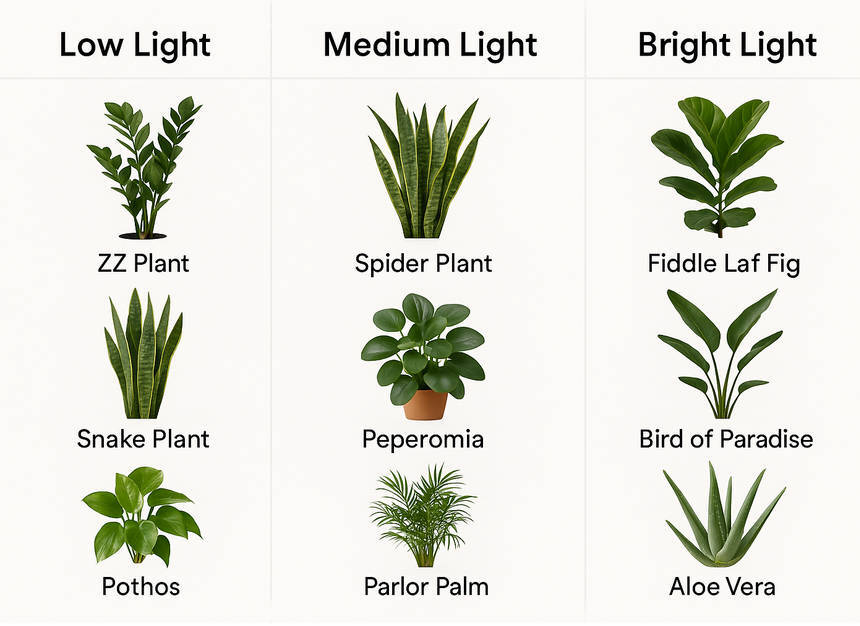
Even the best planter is only as good as the plant in it. Matching the right plant to the light conditions of each office area is key to long-term success (and happy, healthy greenery).
Here’s a quick guide on light levels commonly found in office common areas and some plants that thrive in each:
- Low Light (Corridors, Elevator Banks): These areas get little to no natural light, so go for tough, low-maintenance plants like snake plant, ZZ plant, or Aglaonema. They do well under fluorescent lights and add life to dim hallways or corners.
- Medium Light (Lounges, Interior Lobbies): In spots with filtered or indirect light, use plants like dracaena, rubber plant, or kentia palm. These hold their shape and color with just a bit of natural light, and they’re ideal for spaces away from direct sun.
- Bright Light (Near Windows, Atriums): For sun-filled areas, try fiddle leaf fig, ficus Alii, bamboo palm, or umbrella plant. They grow fast, love the light, and can fill large planters beautifully. Just water a bit more often in bright zones.
- Planter + Plant Height Tips: Think about the total height you’re working with — planter + plant. Use shorter combos where you want open sightlines. For privacy or visual impact, pair a tall plant with a tall planter to build height. For example, a 5′ palm in a 30″ planter gives you a bold 8′ green feature.
Design for Wellness
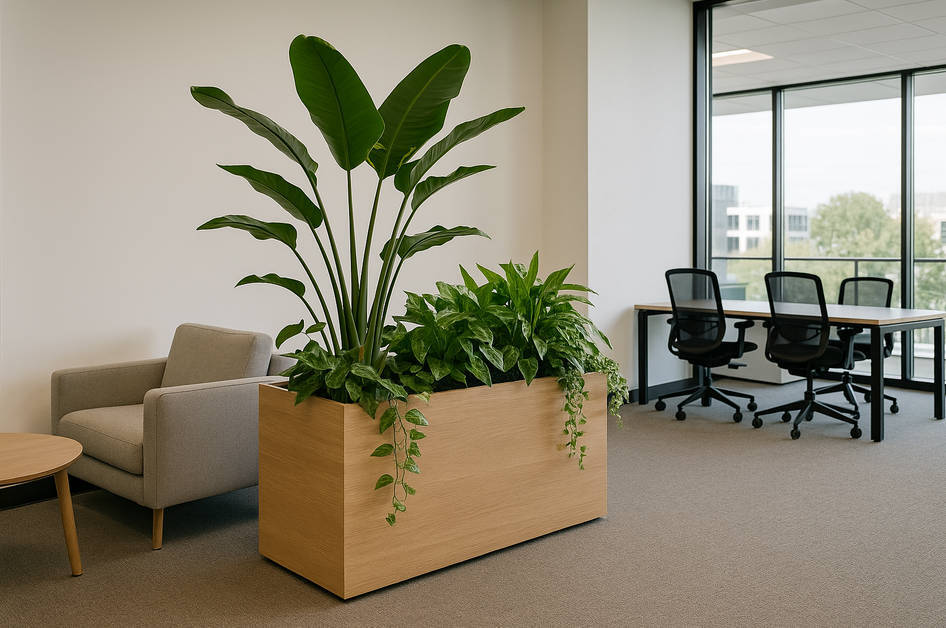
In modern offices, biophilic design, incorporating natural elements like plants, isn’t just about looks. It’s about how a space feels and supports well-being.
Here are some simple design heuristics (rules of thumb) to maximize the wellness benefits of your planters, along with planning tips for practical implementation:
- Place Planters Where People Pause: Add greenery where people linger, like reception desks, coffee stations, or outside meeting rooms. These touchpoints help reduce stress and create a calmer feel.
- Align with Visual Axes: Use plants as visual anchors. A planter at the end of a hallway or in the line of sight from an entrance adds depth and makes navigation more intuitive.
- Green Buffers for Stress Reduction: Planters can act as subtle dividers between high-traffic and quiet zones. This helps people feel more comfortable without needing full walls or partitions.
- Groupings Trump Scattered Singles: Clusters of planters have more visual impact than scattered singles. Use groups of three in varied heights for a fuller, more intentional look.
- Use Plants as Design Accents, Not Afterthoughts: Incorporate planters into the layout early. A tall planter can take the place of a side table or act as a visual anchor and not just filler.
- Don’t Block Critical Signage or Sightlines: Make sure greenery doesn’t block emergency exits, windows, or signage. Low planters or wheeled ones work well near windows and help keep the space flexible.
Note: Use these heuristics as friendly design guidance; always verify local code, accessibility, and safety requirements for your specific environment.
Acoustic & Wayfinding Benefits
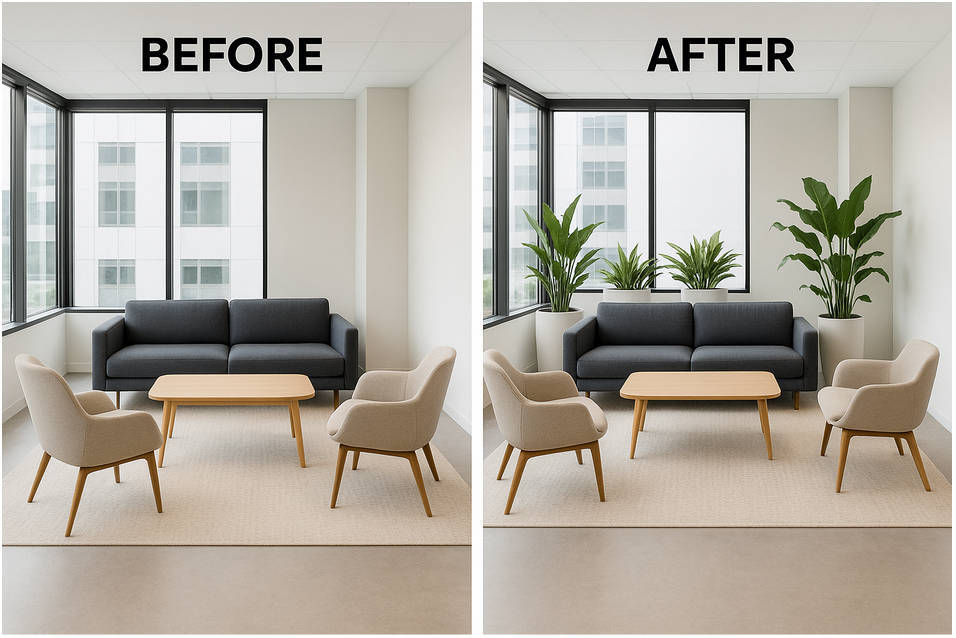
Planters don’t just look good; they work hard for your office environment in ways you might not expect. Two notable benefits: noise reduction and natural wayfinding. Here’s how thoughtful placement of plants and planters can make your common areas quieter and easier to navigate:
- Soften the Acoustics: Plants help absorb sound. In echo-prone areas like lounges or cafés with hard surfaces, planters filled with leafy plants can reduce noise and soften the feel of the space. While they don’t replace acoustic panels, they’re a great visual and acoustic buffer.
- Planters as Wayfinding Cues: Planters act as natural guides. A bold planter near a junction or a row of matching planters along a hallway can subtly lead people where you want them to go. Unlike signs, they’re visual, attractive, and instinctive.
- Defining Zones and Queues: Use planters to define lines, paths, or seating areas without ropes or walls. A row of slim rectangular planters can shape a waiting area or separate walking zones, adding structure and style at the same time.
- Safety and Visibility: Keep planters low or spaced out near corners so they don’t block sightlines. Floor planters are naturally cane-detectable, but avoid anything that juts out above knee height unless it’s grounded and visible.
How to Install (and Move) Planters in Common Areas
So you’ve chosen the perfect planters and plants; now, how do you get them set up correctly without any hiccups? Proper installation ensures both the safety and longevity of your office planters.
Follow these practical steps to install (and later relocate) planters in your office common areas:
- Prep the Spot & Protect Floors: Make sure the planter won’t block doors, signs, or walkways. Use painter’s tape to map out placement if needed. Lay down a mat or felt pads to avoid scratches and protect against spills.
- Position Before You Fill: Place the empty planter where it’s going. Check sightlines, door clearance, and walking space. Adjust now as it’s much easier than after planting.
- Add Liners or Self-Watering Parts: Insert your liner or self-watering system. Make sure everything sits level and any fill tubes or indicators are accessible. Cover any bottom holes with mesh if needed.
- Fill & Plant: Start with lightweight filler (foam blocks, bottles, or mesh bags of peanuts), then add soil. Position the plant, center it, and backfill gently. Leave an inch at the top for watering space. If needed, use stakes or a pebble layer to stabilize taller plants.
- Clean Up & Final Touches: Wipe off smudges, add floor protectors or wheels, and rotate the plant to show its best side. Take a photo of the placement for future reference if it ever gets moved.
|
Mobility Tip: Add casters or sliders under large planters to make future moves easier. Always empty excess water before shifting anything, and go slow to avoid damaging the plant or the floor. |
Bring natural texture and color into your space with our Fiberglass Planters , which are ideal for modern interiors and office designs. Browse our full Office Planters collection to see more styles, or Request a Quote to get personalized pricing for your project.
Frequently Asked Questions
Do indoor planters need drainage?
Yes, but not open drainage. Use sealed planters with liners or hidden reservoirs. Avoid water pooling on floors by using drip trays or self-watering inserts. Controlled drainage is key.
Best planter sizes for corridors and elevator banks?
Stick to slim, tall planters, around 10″ deep and 30″ high for corridors, or 16–18″ cubes for elevator nooks. Leave at least 3 feet clear walkway. Lightweight fiberglass is ideal here.
What materials hold up in high-traffic lobbies?
Fiberglass and powder-coated metal are top picks. Both resist bumps, are easy to clean, and stay looking sharp. Avoid thin plastic or raw wood unless well protected.
How many planters do we need to green a space?
Focus on placement, not just quantity. A few grouped planters (2–3 per key zone) often beat lots of scattered singles. Use tall planters or clusters in main sightlines to make the biggest impact.
Can planters reduce noise?
They help. Lush plants and their containers absorb sound. Place them near walls, corners, or echo-prone areas. They won’t soundproof, but they soften noise and make spaces feel calmer.
Bring Your Office Vision to Life with Modern Planters
Design your common areas in three simple steps. Start by ordering color swatches to find the right finish for your space, then shop office planters to choose styles that fit your layout. When you’re ready, request a quote for a tailored solution that brings your vision to life.

